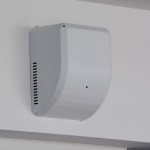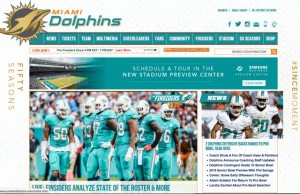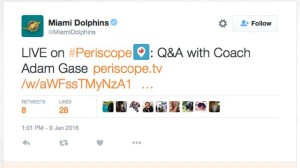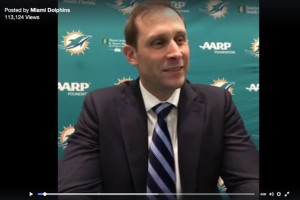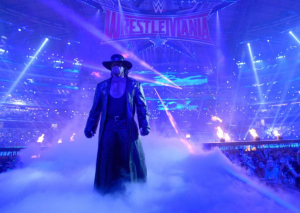Episode 2 of the STADIUM TECH REPORT PODCAST is live, in which hosts Phil Harvey and Paul Kapustka bite into the topic of in-seat food ordering and delivery, wondering if it’s the next big thing in stadium services, or something that needs to get better before it gets bigger. Take a listen and offer your takes in the comments section below!
T-Mobile Arena opens in Las Vegas, with 565 Wi-FI APs

T-Mobile Arena, Las Vegas, on the official April 6 opening. All photos: Cox Business (click on any photo for a larger image)
With no deal announced for either league it’s an open-ended question. For now, the 20,000-seat venue, located just west of the strip near the New York New York hotel/casino (right next to the freeway) will have to be satisfied hosting all kinds of events from concerts to one-off sports events like the Harlem Globetrotters (April 19) and a WWE event in June. Fans at any event will be able to use free Wi-Fi provided by Cox Business, which is the “exclusive Technology Integration/Telecommunications Services Provider,” according to a press release from the official opening ceremonies.
While we haven’t visited the arena yet — we are looking forward to a hosted tour during this summer’s SEAT Conference in July — the $375 million multi-purpose venue, owned by a joint venture between AEG and MGM Resorts International, looks pretty cool with its overhanging lounges and outdoor plaza with real, live trees, a rarity on the strip. Inside, the tech underpinnings sound state of the art, beginning with a 10-Gigabit fiber optic network that serves as the arena’s backbone.
Special shrouds for the Wi-Fi APs
According to figures provided to us by Cox Business folks, the 565 Wi-FI APs include a mix of indoor and outdoor models from Cisco, some designed for office-type settings and some designed to withstand outdoor temperatures and weather. According to Cox its on-site engineers also designed a “vanity cover” type of shroud, which is more aesthetically pleasing to the eye while also helping keep the AP safe from “disruptions,” like possibly being bumped or some other physical intrusion.The arena will also use Cisco’s StadiumVision system to provide synchronized content feeds to the 767 4K-capable digital displays throughout the venue. Thanks to the Cox sponsorship, that content could include “all 60 channels of high-definition news, sports and entertainment content from the Cox cable channel lineup as well as live in-house feeds from the arena,” according to Cox.
We have also heard reports, but have not confirmed with the company, that Mobilitie will be providing the in-venue DAS. Mobilitie’s involvement is not a big surprise, given that the company partnered with MGM in the past to bring Wi-Fi to the resort company’s casinos. Back when the T-Mobile naming sponsorship was announced, there were reports of special discounts and VIP access for T-Mobile customers, but so far none of that information was easily discovered on the arena’s website. Stay tuned for more updates as we get them on the DAS/cellular side of things; anyone who visits the arena soon should take a speedtest and post the results here in the comments.
NEW! Stadium Tech Report Podcast, Episode 1: What does Super Bowl 50’s Wi-Fi record mean for stadium tech pros?
Welcome to the inaugural episode of the STADIUM TECH REPORT PODCAST, with Mobile Sports Report editor Paul Kapustka and host Phil Harvey. In this first show Phil and Paul talk about the Wi-Fi and DAS records set at the recent Super Bowl 50 at Levi’s Stadium, exploring what those numbers mean for stadium tech professionals who are deploying their own networks — and whether or not there will ever be an end to the continuing explosive growth in demand for in-venue bandwidth.
Take a listen and let us know what you think in the comments!
UPDATE: WrestleMania 32 sets new Wi-Fi mark at AT&T Stadium; total Wi-Fi + DAS hits 8.6 TB
UPDATE: Fixes an MSR calculation error on DAS figures.
The 101,763 fans who filled AT&T Stadium Sunday for WrestleMania 32 set new stadium records for Wi-Fi, according to figures provided by AT&T Stadium and AT&T, with 6.77 terabytes of Wi-Fi traffic and an additional 1.9 TB on the AT&T network on the stadium’s DAS for a total wireless figure of 8.6 TB.
The Wi-Fi numbers put Sunday’s signature WWE event (also the biggest WrestleMania by attendance) into second place in our unofficial record-keeping of the largest single-day Wi-Fi traffic stadium events. Only Super Bowl 50 at Levi’s Stadium earlier this year was bigger, with 10.1 TB of Wi-Fi traffic. So far, WrestleMania 32 is also now third in combined Wi-Fi and DAS figures, trailing Super Bowl 50 and Super Bowl XLIX (see charts below).
THE NEW TOP 3 TOTAL USAGE
1. Super Bowl 50, Levi’s Stadium, Santa Clara, Calif., Feb. 7, 2016: Wi-Fi: 10.1 TB; DAS: 15.9 TB; Total: 26 TB
2. Super Bowl XLIX, University of Phoenix Stadium, Glendale, Ariz., Feb. 1, 2015: Wi-Fi: 6.23 TB; DAS: 6.56 TB**; Total: 12.79 TB**
3. WrestleMania 32, AT&T Stadium, Arlington, Texas, April 3, 2016: Wi-Fi: 6.77 TB; DAS: 1.9 TB*; Total: 8.6 TB*
* = AT&T DAS stats only
** = AT&T, Verizon Wireless and Sprint DAS stats only
THE NEW TOP 5 FOR WI-FI
1. Super Bowl 50, Levi’s Stadium, Santa Clara, Calif., Feb. 7, 2016: Wi-Fi: 10.1 TB
2. WrestleMania 32, AT&T Stadium, Arlington, Texas, April 3, 2016: Wi-Fi: 6.77 TB
3. Super Bowl XLIX, University of Phoenix Stadium, Glendale, Ariz., Feb. 1, 2015: Wi-Fi: 6.23 TB
4. Alabama vs. Texas A&M, Kyle Field, College Station, Texas, Oct. 17, 2015: Wi-Fi: 5.7 TB
5. College Football Playoff championship game, AT&T Stadium, Arlington, Texas, Jan. 12, 2015: Wi-Fi: 4.93 TB
Wi-Fi not to blame for stadium entry issues
John Winborn, chief information officer for the Dallas Cowboys Football Club, said in an email that the reported claims of the Wi-Fi being offline Sunday — and that being the reason why entry lines were long and slow — were not true. While Winborn did admit that one single Wi-Fi AP (out of the more than 2,000 in the stadium’s network) was offline and there were “a couple issues” with ticket scanners, he said “there were no Wi-Fi issues that would have had a significant impact on ingress.” Other reports have claimed the doors were opened later due to extended show rehearsals, while commenters on MSR’s posts have claimed that a lack of wristbands for stadium-floor seating also led to seating issues even for fans already inside the main building entrances. So far, we have not seen any official explanation for the delays other than the official apology from the stadium and the WWE:
“To ensure the safety of WWE fans, increased security measures were put in place tonight. We apologize that it may have taken some fans longer than usual to get into AT&T Stadium.”
During Sunday’s event Winborn said the Wi-Fi network saw 20,462 concurrent and 34,951 total user connections, some via a network of 150 temporary Wi-Fi APs installed among the seats on the stadium floor.
Twitter to stream NFL Thursday night games to all platforms, including smartphones
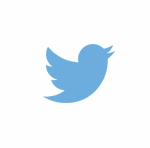 The big news from the NFL today was a deal signed with Twitter, under which Twitter will get to stream live NFL Thursday Night games online to any connected device, including smartphones. To us, that last bit is the most interesting part of the deal since it breaks the previous stronghold held by Verizon Wireless and its NFL Mobile deal, under which Verizon was previously the sole provider of live NFL action to smartphones.
The big news from the NFL today was a deal signed with Twitter, under which Twitter will get to stream live NFL Thursday Night games online to any connected device, including smartphones. To us, that last bit is the most interesting part of the deal since it breaks the previous stronghold held by Verizon Wireless and its NFL Mobile deal, under which Verizon was previously the sole provider of live NFL action to smartphones.
While many NFL games have been streamed by various entities online — including recent years’ playoff games, the Super Bowl and Monday Night Football — for most of those “broadcasts” you could only watch on a phone-type device if you were a Verizon customer and used the NFL Mobile app. The only exception we know of for U.S. fans was the extra-price DirecTV Sunday Ticket package, which also allowed for mobile viewing; but for free online action, you could typically only watch on a PC, connected TV or a tablet — smartphones were the exclusive domain of Verizon.
Under the Twitter deal, fans who are Twitter users will be able to watch Thursday night games free of any other charge, on tablets, PCs, connected TVs and smartphones, according to a release today from the NFL and Twitter. In addition to live action, the league and Twitter promise pre-game extras like Periscope broadcasts from teams and players, meaning you will get low-quality jittery interviews instead of professionally produced material. But we jest. The Periscope broadcasts could be cool, especially if they are on the field where fans never really get to be.
The Twitter deal follows on the heels of last season’s Yahoo-streamed game, which attracted 15.2 million viewers. It will be interesting to see what the numbers are for Twitter this year, since the Thursday night games will be available on regular TV from both NBC and CBS, which have five games each, as well as on the NFL Network, which will simulcast all games on Thursday nights.
